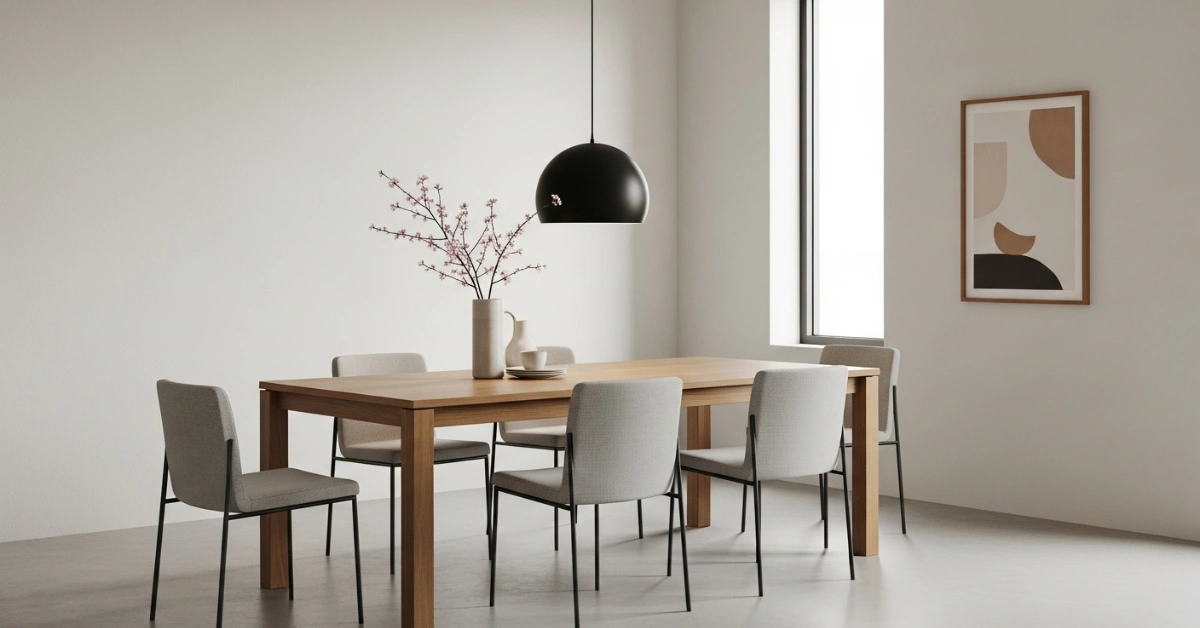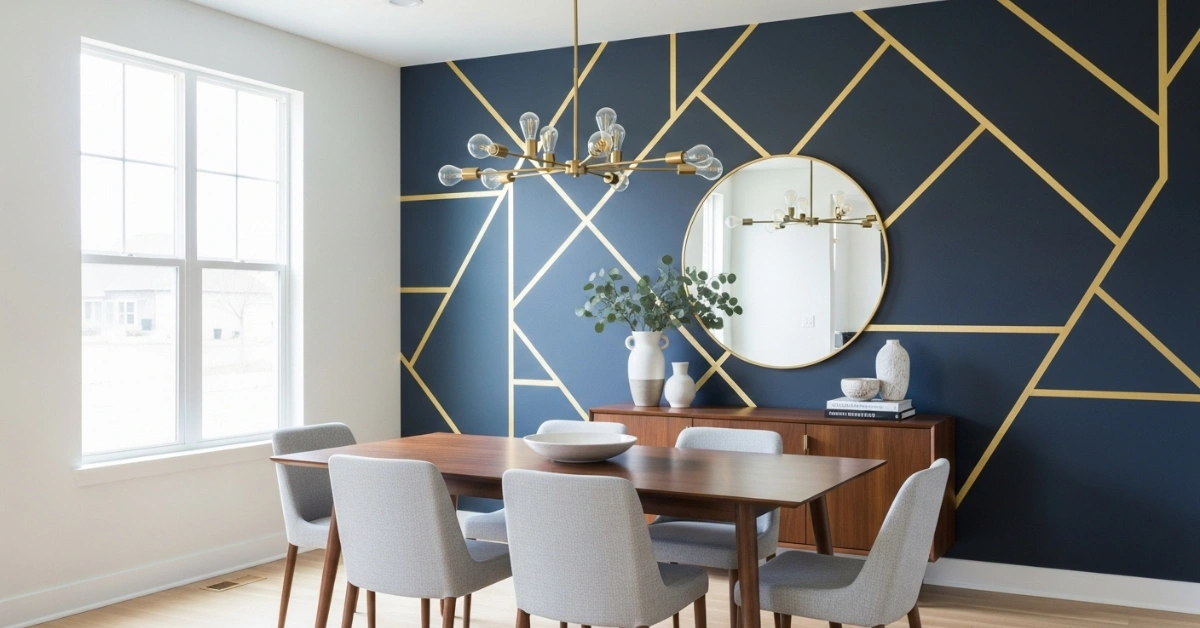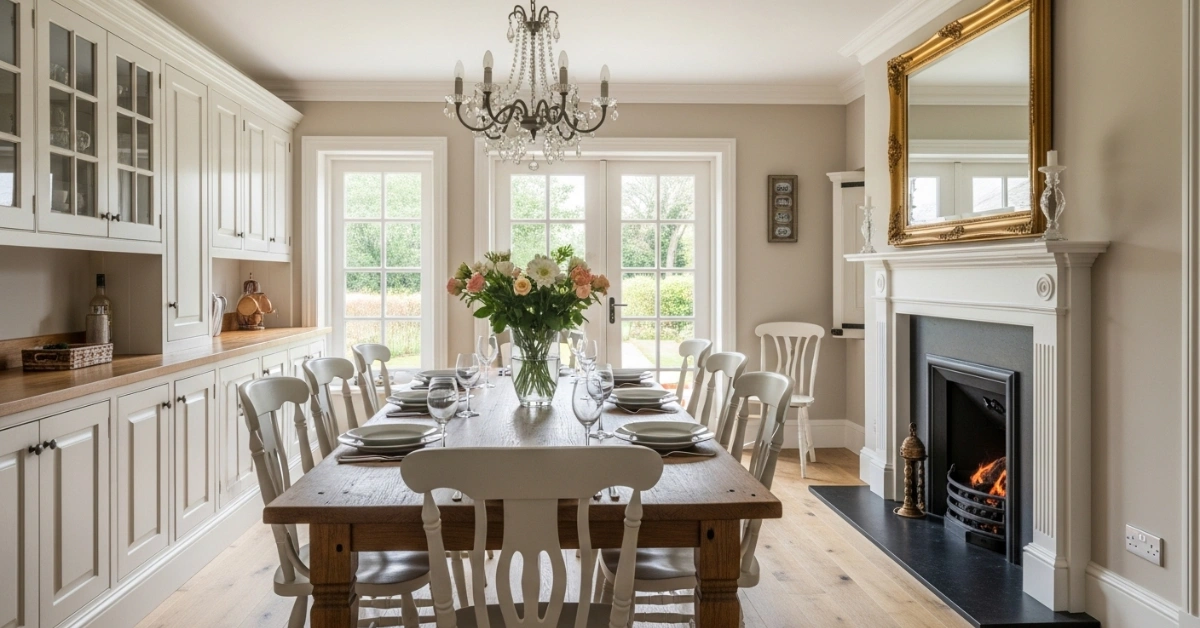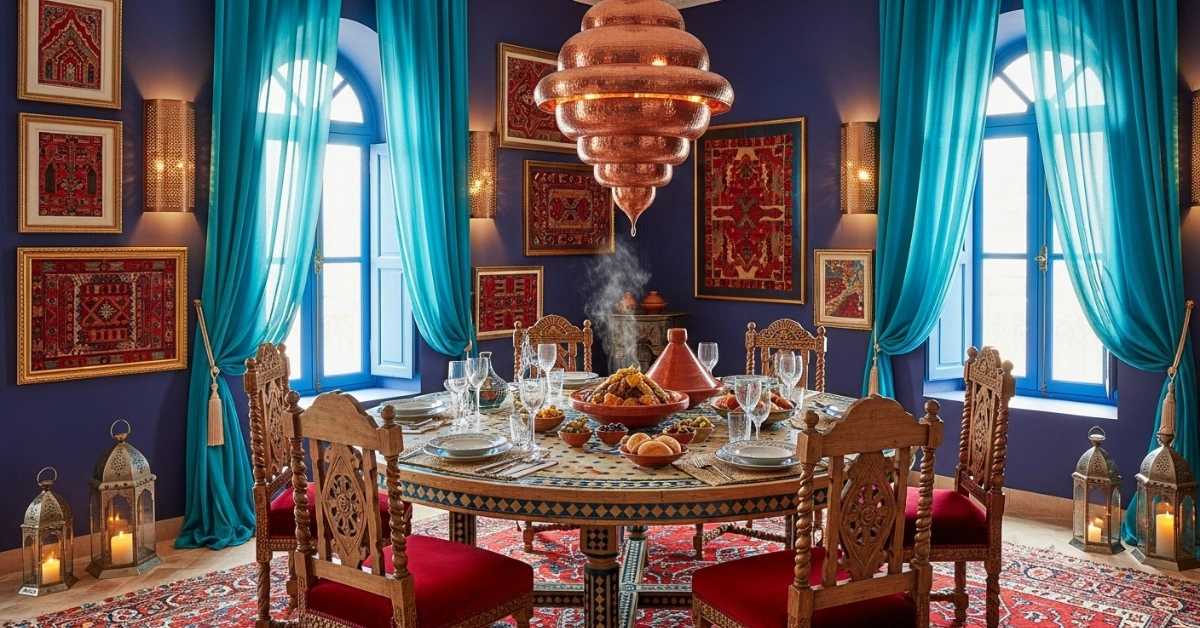Minimalist Dining Room: 25 Simple & Stylish Ideas

In today’s fast-paced world, a cluttered dining space can feel overwhelming, making meals less enjoyable and gatherings stressful. Many homeowners struggle to balance functionality with aesthetics, ending up with dining rooms that feel chaotic or uninspired. A minimalist dining room offers a solution by embracing simplicity, clean lines, and purposeful design to create a serene, inviting space. This guide provides practical tips, expert insights, and creative ideas to transform your dining area into a stylish, functional haven that enhances every meal and moment.

What is Minimalist Design?
Minimalist design focuses on simplicity, functionality, and intentionality. Originating from the mid-20th century, influenced by Japanese Zen philosophy and Scandinavian aesthetics, it emphasizes “less is more.” According to the Museum of Modern Art, minimalism strips away excess to highlight form and purpose, creating spaces that feel calm and uncluttered.
In a dining room, this translates to clean lines, neutral colors, and carefully chosen furniture. The goal is to craft a space that feels open, airy, and timeless while serving its primary function: bringing people together for meals and conversation.

Key Principles of Minimalist Design
- Simplicity: Use only essential elements to avoid visual clutter.
- Functionality: Every piece should serve a purpose.
- Neutral Palette: Stick to soft, muted tones for a calming effect.
- Quality Over Quantity: Invest in durable, high-quality items.
- Open Space: Prioritize negative space to create a sense of freedom.
Why Choose a Minimalist Dining Room?
A minimalist dining room isn’t just about aesthetics, it’s about creating a space that enhances your lifestyle. Here’s why it’s a smart choice:
- Reduces Stress: A clutter-free environment promotes relaxation, as supported by a 2016 study in the Journal of Environmental Psychology, which linked tidy spaces to lower stress levels.
- Easy Maintenance: Fewer items mean less cleaning and upkeep.
- Timeless Appeal: Minimalist designs avoid trendy fads, ensuring longevity.
- Versatility: The neutral aesthetic adapts to various occasions, from casual dinners to formal gatherings.
- Sustainability: Investing in fewer, high-quality pieces reduces waste, aligning with eco-conscious living.

Interior designer Sarah Thompson shares, “A minimalist dining room lets the experience of dining, good food, great company, take center stage. It’s about creating a backdrop that supports connection.”
How to Design a Minimalist Dining Room: Step-by-Step Guide
Creating a minimalist dining room requires thoughtful planning. Below is a detailed guide to help you achieve a balanced, stylish space.
1. Start with a Neutral Color Palette
A minimalist dining room thrives on a cohesive, neutral color scheme. Think whites, beiges, grays, or soft pastels. These hues create a calm atmosphere and make the room feel larger.
- Wall Colors: Opt for matte white or light gray for a clean backdrop. For warmth, consider creamy beige or taupe.
- Accents: Introduce subtle contrast with black or wood tones in furniture or decor.
- Tip: Use one accent color sparingly (e.g., a muted green vase) to add personality without overwhelming the space.

In my own home, I painted the dining room walls a soft dove gray and paired it with a white oak table. The result was a warm yet airy space that felt inviting for both daily meals and special occasions.
2. Choose Simple, Functional Furniture
The dining table and chairs are the heart of the room. Prioritize quality and simplicity when selecting pieces.
Dining Table
- Shape: Rectangular or oval tables work best for minimalism, as their clean lines complement the aesthetic.
- Material: Wood (oak, walnut) or glass adds sophistication without fuss. Avoid ornate carvings or heavy embellishments.
- Size: Choose a table that fits your space without dominating it. A 6–8-person table is versatile for most homes.

Chairs
- Design: Look for sleek, armless chairs with clean lines. Scandinavian-style chairs with tapered legs are a popular choice.
- Upholstery: Opt for neutral fabrics like linen or leather for durability and elegance.
- Tip: Mix materials (e.g., wood table with metal chairs) for subtle contrast.

Designer Emily Carter advises, “Invest in a dining table that feels timeless. A solid wood piece with a simple silhouette can last decades and adapt to any style.”
Example Furniture Selection
| Item | Material | Style | Price Range |
|---|---|---|---|
| Dining Table | White Oak | Rectangular, Tapered Legs | $800–$2,000 |
| Dining Chairs | Linen Upholstery | Armless, Minimalist | $100–$300 |
| Sideboard | Walnut | Sleek, Handle-less | $500–$1,500 |
3. Maximize Natural Light
Lighting is crucial in a minimalist dining room. Natural light enhances the open, airy feel, so avoid heavy curtains or cluttered window treatments.
- Windows: Use sheer blinds or linen curtains to diffuse light softly.
- Mirrors: Place a large mirror opposite a window to reflect light and make the space feel larger.
- Artificial Lighting: Choose a single statement pendant light with a simple design (e.g., a matte black or brass fixture). Avoid chandeliers with excessive embellishments.

A friend of mine transformed her small dining room by installing floor-to-ceiling sheer curtains. The room instantly felt brighter and more spacious, proving that light is a minimalist’s best friend.
4. Declutter with Smart Storage
Minimalism doesn’t mean zero storage, it means strategic storage. Keep surfaces clear by incorporating discreet solutions.
- Sideboard: A sleek, low-profile sideboard can store dishes and linens. Choose one with clean lines and minimal hardware.
- Built-ins: If space allows, built-in shelves painted to match the walls blend seamlessly.
- Hidden Storage: Consider a dining table with built-in drawers for napkins or placemats.

5. Add Thoughtful Decor
Minimalist decor is about restraint. Every piece should have a purpose or spark joy, as Marie Kondo famously suggests.
- Centerpiece: A single ceramic vase, a wooden bowl with fruit, or a low-profile floral arrangement works well.
- Wall Art: Opt for one large piece (e.g., an abstract print in neutral tones) rather than a gallery wall.
- Textiles: Use simple linen or cotton table runners and napkins in muted colors.

Interior designer Michael Lee notes, “In a minimalist dining room, one carefully chosen decor piece can have more impact than a dozen random items. It’s about intentionality.”
6. Incorporate Natural Elements
Natural materials add warmth and texture without disrupting the minimalist aesthetic.
- Wood: A wooden table or chairs bring organic charm.
- Plants: A single potted plant (e.g., a fiddle leaf fig or monstera) adds life. Avoid overcrowding with too many plants.
- Stone: A marble or quartz tabletop can elevate the space subtly.
In a recent project, I added a single large fern in a ceramic pot to a minimalist dining room. It became the focal point, adding vibrancy without clutter.

7. Prioritize Comfort and Functionality
A minimalist dining room should feel welcoming. Ensure chairs are comfortable for long dinners, and the table height suits your needs (standard is 30 inches). Test furniture layouts to ensure easy movement, aim for at least 36 inches of clearance around the table.

Common Mistakes to Avoid in a Minimalist Dining Room
Even with the best intentions, it’s easy to stray from minimalist principles. Here are pitfalls to watch out for:
- Over-Decorating: Adding too many accessories can ruin the clean aesthetic. Stick to one or two statement pieces.
- Ignoring Scale: Oversized furniture can overwhelm a small space. Measure your room carefully before buying.
- Clashing Colors: Stick to a cohesive palette to maintain harmony.
- Poor Lighting: Dim or harsh lighting can make the space feel uninviting. Balance natural and artificial light.
- Neglecting Comfort: Aesthetic shouldn’t trump function. Ensure seating is comfortable for long meals.
Minimalist Dining Room Inspiration: 5 Design Ideas
Need a spark of creativity? Here are five minimalist dining room ideas to inspire your project, each tailored to different tastes and spaces.
1. Scandinavian Simplicity
- Features: Blonde wood table, white walls, and linen-upholstered chairs.
- Decor: A single pendant light and a small potted plant.
- Best For: Small spaces or apartments needing a cozy yet open feel.

2. Monochrome Elegance
- Features: Black table, black chairs, and white walls for high contrast.
- Decor: A single abstract black-and-white artwork.
- Best For: Modern homes aiming for bold sophistication.

3. Warm Minimalism
- Features: Walnut table, beige chairs, and warm gray walls.
- Decor: A woven table runner and a ceramic vase.
- Best For: Families wanting a cozy, inviting space.

4. Industrial Minimalism
- Features: Concrete or glass table, metal chairs, and exposed brick accents.
- Decor: A sleek pendant light and a single succulent.
- Best For: Urban lofts or edgy aesthetics.

5. Coastal Minimalism
- Features: White oak table, light blue accents, and sheer curtains.
- Decor: A driftwood centerpiece and a woven rug.
- Best For: Homes near water or those seeking a breezy vibe.

Budget-Friendly Tips for a Minimalist Dining Room
Creating a minimalist dining room doesn’t have to break the bank. Here are practical ways to save:
- Shop Secondhand: Look for solid wood tables or chairs at thrift stores or online marketplaces like Craigslist.
- DIY Decor: Create a centerpiece with items you already own, like a glass jar filled with pebbles.
- Repurpose: Paint an old table in a neutral color to give it new life.
- Invest Gradually: Start with a quality table and add chairs over time to spread out costs.

A colleague of mine revamped her dining room for under $500 by refinishing a thrift-store table and pairing it with affordable linen chairs from a big-box retailer. The result was stunning and budget-friendly.
Maintaining Your Minimalist Dining Room
To keep your space looking fresh and functional:
- Declutter Regularly: Assess decor every few months and remove anything unnecessary.
- Clean Smartly: Use gentle cleaners on wood or glass to preserve finishes.
- Rotate Decor: Swap out a centerpiece seasonally to keep the space dynamic without adding clutter.
- Check Lighting: Dust light fixtures and replace bulbs to maintain brightness.

Conclusion:
A minimalist dining room is more than a design choice, it’s a lifestyle that prioritizes calm, connection, and intentionality. By focusing on simplicity, quality, and functionality, you can create a space that’s both beautiful and practical, perfect for everyday meals and special gatherings. Start small, choose pieces you love, and let your dining room become a sanctuary of style and serenity.
Ready to transform your dining space? Begin by decluttering your current setup and picking one tip from this guide to implement today. Share your minimalist dining room journey in the comments or tag us on social media—we’d love to see your space come to life!






